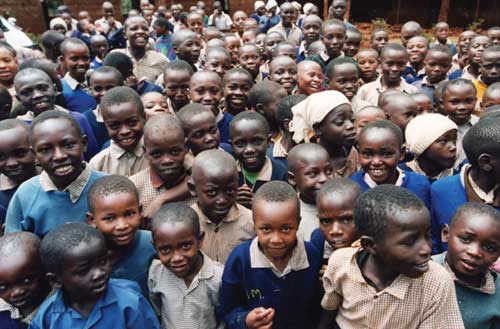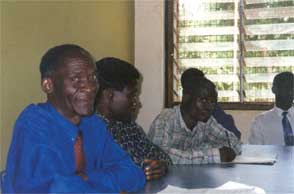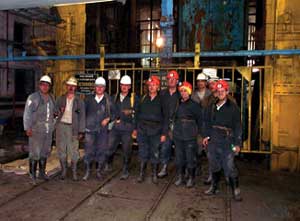 |
|
Photo: TIBIA/R. Romano
School children in Kenya take a break
from their studies. The U.S. Department of Labor currently funds efforts around
the world to promote access to quality basic education for children who are
working or at risk of engaging in the worst forms of child labor. Twenty-two
projects are underway in 19 African countries, including Kenya. |
Overview
The challenges of reducing the exploitation of child labor,
strengthening social safety nets, and improving core labor standards need to be
addressed in the context of today’s global environment. As the economies
of the world continue to become more interdependent and subject to new, common
security threats, the need to implement a broad based approach to achieving
sustainable economic development becomes all the more significant. The
Department’s Bureau of International Labor Affairs (ILAB) provides policy
guidance on labor related issues and technical cooperation, which actively
support a free and open trading system that will strengthen the global economy
and permit democracy to flourish.
The International Labor Organization (ILO) estimates some 211 million
children between the ages of 5 and 14 were working around the world in 2000.
Many of these children work under extremely hazardous and exploitative
conditions. Millions of adult workers are also denied their basic labor rights.
They are forced to work under modern forms of slavery such as bonded labor,
denied their right to associate freely and bargain collectively, or legally
discriminated against. Many other workers live in countries that are unable to
provide even the most basic social safety nets in times of crisis.
Serving the Public
The Department began its international efforts in 1950 to assist with
European reconstruction and now supports a wide range of projects in every
region of the world, working closely with the Department of State, the U.S.
Agency for International Development, U.S. embassies, and international
organizations. ILAB and U.S. embassies abroad work closely with the tripartite
partners at the national level to design projects that complement rather than
duplicate existing efforts. In 2002, ILAB expanded its network of organizations
through a competitive bidding process, establishing partnerships with several
new organizations including well-recognized international, non-governmental,
faith-based, and other organizations.
The Department has been instrumental in promoting the progressive
elimination of child labor around the world since 1995. DOL’s support for
ILO’s International Program on the Elimination of Child Labor projects
comprise a number of activities including: direct action aimed at removing or
preventing a specified number of children from engaging in exploitative work
and providing them with education or training opportunities; income generating
alternatives for parents; public awareness and social mobilization; capacity
building and policy reform; establishing formal and informal monitoring
systems; and increasing the knowledge base on child labor. In 2002, DOL funding
supported larger, more comprehensive, national level programs that partner with
governments and other institutions to combat the worst forms of child labor.
Recognizing the importance of basic education as a powerful alternative to
child labor, the Department also supports targeted education-based efforts
specifically in areas where there is a high incidence of exploitative child
labor. All of ILAB’s technical assistance activities are guided and
supported by a strong policy and research component.
ILAB’s projects in the areas of protecting workers’ rights
and strengthening basic social safety nets address a range of issues including:
strengthening the administration of labor laws; improving the capacity to
prevent and resolve disputes; strengthening social insurance systems; improving
workplace safety and health; enhancing the capacity of job training and
employment services; and providing greater employment opportunities for persons
with disabilities and for women. In addition, the Department expanded an
initiative to strengthen the response to the HIV/AIDS crisis through workplace
based prevention education programs, as the pandemic continues to create major
disruptions in the global workforce. In FY 2002, 41 countries also committed to
undertake improvements in assuring compliance and implementation of core labor
standards.
Program Costs
Net costs in FY 2002 were $106 million dollars. This represents in
large part the support to international grant programs. The increased level of
net costs in FY 2002 is a result of expenditures from budget authority in FY
2002 and previous fiscal years.
Text version
To make a difference in the lives of children and workers around the
world and combat abuses, the Department administers technical assistance
programs aimed at reducing exploitative child labor, advancing internationally
recognized workers’ rights, and strengthening social safety nets. In FY
2002, the Department contributed $45 million to the ILO’s International
Program on the Elimination of Child Labor, bringing the total contribution
since 1995 to approximately $157 million. In 2001 and 2002, DOL also received
$74 million for its Child Labor Education Initiative to increase access to
basic education in countries with a high incidence of child labor.
In FY 2002, the Department contributed $18.5 million to efforts to
implement the Declaration on Fundamental Principles and Rights at Work. ILAB
awarded $20 million in grants and contracts to social safety net projects that
provide workers with the tools and support to benefit from a more open and
integrated world economy. In 2001 and 2002, ILAB awarded $18.5 million in
grants to HIV/AIDS workplace education projects that lessen the impact of the
pandemic on workers and improve trends in economic development that have been
in decline due to the global crisis.
DOL Challenges for the Future
Poverty has been frequently cited as a major cause of child labor. As
many of the world’s working children come from socially and economically
disadvantaged backgrounds, efforts to combat child labor must be linked to
poverty alleviation strategies and overall economic development. Another
important factor, which also needs to be addressed, is the degree to which
children have meaningful alternatives to work, such as access to affordable,
quality schooling, and sustained support so that they remain in school.
Finally, DOL-funded programs must work within difficult political and economic
environments that are susceptible to frequent instability and uncertainty.
Reduce Child Labor in Developing Countries
Reduce exploitative child labor by promoting international efforts
and targeting focused initiatives in selected countries.
Results: The goal was fully achieved. The Department targeted
five performance indicators to measure success against this goal, and exceeded
all five of the indicators.
Program Description: Since 1993, the Department’s Bureau of
International Labor Affairs (ILAB) has been engaged in the fight to combat
child labor worldwide. ILAB’s activities include research and reporting on
various aspects of international child labor, public awareness and
understanding of the issue, and support for technical assistance programs that
aim to eliminate child labor and increase access to basic quality education.
DOL supports the International Labor Organization’s International
Program on the Elimination of Child Labor (ILO/IPEC), a worldwide technical
assistance program aimed at the progressive elimination of child labor.
DOL’s contributions target efforts in 50 developing countries around the
globe. Initiatives include removing children from exploitative work and
preventing other at-risk children from entering hazardous child labor
situations. Key strategies include direct assistance to children and families,
such as education and training, and strengthening the ability of nations to
address child labor situations. DOL assistance has also enabled IPEC to conduct
child labor surveys and furthered efforts to raise awareness about child labor
around the world. Last year, the Department supported the launch of a new
ILO/IPEC initiative, the Timebound Program, designed to eliminate the worst
forms of child labor in a country within a specified period of time. DOL has
supported five Timebound programs in El Salvador, the Dominican Republic,
Nepal, the Philippines, and Tanzania.
In FY 2001, the Department supported a new Child Labor Education
Initiative, which seeks to improve the accessibility and quality of basic
education in areas with a high incidence of exploitative child labor. Through
this initiative, DOL has awarded grants to organizations in nine countries,
with a special focus on improving access and quality of education for child
laborers or children at risk of engaging in hazardous work.
Analysis of Results:
- 15 countries will ratify International Labor Organization (ILO)
Convention 182 on the Worst Forms of Child Labor.
Twenty-nine countries ratified ILO Convention 182 on the Worst Forms of
Child Labor, reflecting positively on DOL’s efforts at advocacy in this
area and demonstrating the extensive international commitment to end
exploitative child labor. Convention No. 182, ratified by the United States in
1999, has had the fastest ratification rate of any ILO Convention. As of the
end of FY 2002, a total of 129 countries have ratified the convention.
- 10 countries will establish action plans to combat child labor and/or
promote access to basic education for child laborers or children at risk.
In FY 2002, 13 countries established a total of 15 new action plans,
demonstrating concrete commitments at the highest levels of local and national
government to eliminate child labor. Many countries develop comprehensive
national plans that target all working children, while some focus on specific
worst forms of child labor, such as commercial sexual exploitation,
trafficking, and bonded child labor. DOL funding contributed to the development
of almost all of the plans, reflecting the Department’s strong
encouragement of establishing frameworks for action to eliminate child
labor.
Text version
|
Preventing Child Labor or Removing Children
from Exploitative Work |
|
Indicator |
FY 2000 |
FY 2001 Result
|
FY 2001 Goal
|
FY 2002 Goal |
FY 2002 Result
|
|
Countries ratifying ILO Convention
|
36 |
25 |
63 |
15 |
29 |
|
Countries that establish new action plans to
eliminate child labor |
- |
15 |
13 |
10 |
13 |
|
Children targeted for prevention or removal
from exploitative work |
109,000 |
100,000 |
199,336 |
90,000 |
103,772 |
|
Children actually prevented or removed from
exploitative work |
- |
50,000 |
25,885 |
50,000 |
51,922 |
|
Education Projects targeting child laborers
|
- |
- |
- |
8 |
9 |
- 90,000 children targeted for prevention and removal from exploitative
work, particularly its worst forms (as defined in ILO Convention 182) through
the funding of new DOL-IPEC programs.
With the significant contribution of $45 million for IPEC activities
and a focus on larger direct action projects in FY 2002, DOL targeted more than
103,000 children for prevention and withdrawal from exploitative work. The
projects will provide the targeted children with educational or training
opportunities and their parents with viable economic alternatives. IPEC
projects that target children for direct assistance are comprehensive in scope
and include components such as capacity-building and awareness raising for the
local communities, child labor monitoring, data collection, and support
services for the families. DOL-approved IPEC project documents and initial
needs assessments from the field provide the program data for this indicator.
Target numbers may be revised once project activities have started and actual
children have been identified in a given area.
- 50,000 children actually prevented or removed from exploitative
work.
Approximately 52,000 children were removed or prevented from
exploitative work through the provision of education or training opportunities
in ongoing DOL-funded IPEC programs. Selected parents were also provided with
alternative income-generating opportunities, to reduce their reliance on child
labor. The rising levels of success during FY 2002 support the
Department’s expectations that the projects will continue to benefit the
planned numbers of children before their completion. In addition, it is
expected that thousands of other children have indirectly benefited from
activities that include strengthening the capacity of government and partner
groups to address child labor, raising awareness of the risks of child labor
and the benefits of education, and mobilizing communities to take action.
- Education projects for child laborers through the Education
Initiative will begin in eight countries.
DOL’s Child Labor Education Initiative funded education projects
in nine countries: Bolivia, El Salvador, India, Nepal, Pakistan, Peru,
Tanzania, Togo, and Zambia. In addition to these 9 projects, DOL funded an
Education Innovations project that will support community-based organizations
in 18 additional countries.
 |
|
Photo: DOL/ILAB
Children rise early
in the coffee plantations of Trinidad, Honduras and head into the fields.
Without protective clothing they work for hours in harsh weather, planting,
picking, stripping, and sorting coffee beans. Hard work and long hours means
their opportunity for education is minimal. However, a DOL funded project
undertaken by the International Labor Organization is working to combat and
prevent child labor in the coffee industry. The Honduran Coffee Institute
estimates that working children under the age of 18 represent approximately 30
percent of the labor force in the Department of Santa Barbara, or 11,500
workers. This ILO/IPEC project targets 1,200 children for withdrawal and
prevention from work in the coffee industry. The project’s activities
include forming health-schools committees aimed at improving sanitary
conditions in these communities and mobilizing the participation of community
leaders in monitoring attendance to insure the children stay in school. By
working with other organizations such as the faith-based Fondo Cristiano, the
Educatodos program has been provided with teaching materials and school
furnishings. Much needed medicines have also been donated and health care
services provided to program children. |
Strategies: Experience has shown that the time period required
to demonstrate results through direct action activities aimed at eliminating
child labor varies significantly. To sustain efforts, countries and local
communities must offer meaningful alternatives to exploitative work for the
children and their families, often entailing extensive preparatory work to
mobilize communities and build the capacity of local organizations to provide
quality educational opportunities. Furthermore, the child labor efforts
underway work in countries with diverse political, social, and economic
environments, where civil unrest, economic shocks, and frequent changes in
governments can impact the timely progress of initiatives. To ensure that its
child labor and basic education projects are effective and complementary to
existing initiatives, DOL consults closely with U.S. agencies, national
governments and international organizations.
Audits and Program Evaluations: Evaluations are conducted for
all DOL-funded projects and have resulted in greater understanding of project
impact and the relative effectiveness of strategies used. Mid-term evaluations
in particular help ILAB to gauge the relative success of project activities in
the formative stage and identify factors that are likely to affect performance
and to make adjustments where necessary. In addition, these evaluations also
validate and verify the accuracy of data provided in progress reports.
Recommendations and lessons learned that arise from final evaluations are also
being used to enhance program planning and design of future projects. For
example, the final evaluation of a DOL-funded country program recommended the
use of fewer implementing agencies with a focus on the most effective ones. In
turn, such lessons learned and recommendations influenced the designing of the
second phase of the project.
Goal Assessment and Future Plans: As more child labor projects
become fully operational, the Department expects that results reported in FY
2003 will continue to show increases in the numbers of children withdrawn or
prevented from engaging in exploitative work through on-going DOL-funded
projects. DOL will continue to work closely with ILO and other implementing
agencies to obtain detailed information relating to program performance and
anticipated results. The goals and indicators for 2003 have been refined, and
as the Child Labor Education Initiative projects get underway, new indicators
will be developed to measure the persistence and permanence of targeted
children in school settings.
(Goal 3.3A — FY 2002 Annual Performance Plan)
Promote Core Labor Standards and Improve Economic Opportunities for
Workers in Developing Countries
Advance workers’ protections and economic status in developing
countries.
Results: The goal was fully achieved. The Department targeted
two performance indicators to measure success against this goal, and exceeded
both of the indicators.
Program Description: Increasing international trade helps foster
economic growth, raise living standards, and promote employment in the U.S. The
expansion of global trade and investment, the improvement of working
conditions, and the protection of basic worker rights are best understood as
mutually reinforcing, and not mutually exclusive, objectives. As political
developments, market reforms, and the transition to a global economy bring
significant changes to national economies, individual labor market systems need
to change accordingly to remain viable and to support their populations.
The Department’s International Cooperation Program helps address
some of these difficulties by working to ensure that the greatest possible
number of workers benefit from a more open world economy. A majority of
projects funded through the Department’s International Cooperation
Program, therefore, fall under two primary program objectives: Improving
Economic Opportunity and Income Security for Workers — to strengthen
developing countries’ abilities to build and institutionalize social
safety net policies and programs needed to improve working conditions and
foster economic growth; and Protecting the Basic Rights of Workers — to
implement the core labor standards embedded in the International Labor
Organization’s (ILO) Declaration on Fundamental Principles and Rights at
Work.
Text version
|
Indicator |
FY 2000 |
FY 2001 |
FY 2002 |
|
Target |
Result |
Target |
Result |
Target |
Result |
|
Countries committing to undertake
improvements in assuring compliance and implementation of core labor
standard |
8 |
35 |
15 |
43 |
7 |
41 |
|
Countries committing, with DOL assistance,
to improve economic opportunities and income security for workers.
|
4 |
34 |
8 |
10 |
6 |
49 |
The Department is currently implementing more than 55 projects in over
50 countries. Projects vary in size and scope according to country priorities,
need, and intervention strategy. Resources are distributed throughout the
developing world with a small number of global projects. DOL also funds a
number of regional projects covering several countries and/or territories with
a single project.
Analysis of Results: The Department set the targets for FY 2002
based on an assumption of substantially reduced funding availability. Resources
were significantly greater than expected, thereby allowing the target to be
greatly exceeded. In addition, the Department funded regional projects that
covered 29 countries and territories in two projects, enabling the Department
to significantly exceed its goals.
- Seven countries commit to undertake improvements in assuring
compliance and implementation of core labor standards.
Stakeholders in 41 countries and territories made commitments to
implement new projects or to expand already-existing projects designed to
promote and implement core labor standards. New projects will be funded in
Bangladesh, China, Kazakhstan, Madagascar, Mozambique, and Peru. DOL will
expand upon already-existing projects in Cambodia, India, Indonesia, Kenya,
Tanzania, Uganda, eight countries in Central America, and 21 countries and
territories in Anglophone Caribbean.
DOL reached 12 countries directly through country-specific projects.
Two of the total 17 new or continuing projects that received funding in FY 2002
are regional in scope, covering 29 additional countries and thus enabling the
Department to reach 34 more countries than planned.

|
Faculty and students
at Namitete Vocational College in the Republic of Malawi have actively
participated in the HIV/AIDS prevention education and policy project, a
DOL-funded program implemented by Project HOPE. Participants acquire a thorough
knowledge of sexually transmitted illnesses and tuberculosis prevention
measures. At Namitete, the HIV/AIDS message has reached 150 students and 11
faculty. A total of 1,731 students and staff are involved in the project at all
seven vocational colleges in Malawi. |
Examples of projects designed to improve compliance with and
implementation of core labor standards include: a new $4.1 million project in
China to improve the implementation of labor law; the addition of $1.48 million
to an already-existing project to improve labor-management relations in Kenya,
Tanzania, and Uganda; a new $205,000 worker education project in Kazakhstan;
and the addition of $1.59 million to an already-existing project to improve
labor-management relations in 21 countries and territories in Anglophone
Caribbean.
- Six project countries commit with DOL assistance to improve economic
opportunities and income security for workers.
Stakeholders in 49 countries and territories made commitments to
implement new projects or to expand already-existing projects designed to
improve economic opportunities. DOL will fund new projects in Afghanistan,
Argentina, Chile, Mexico, Pakistan, Philippines, Poland, and Slovenia and will
expand upon already-existing projects in Bangladesh, Bolivia, Costa Rica, El
Salvador, India, Lithuania, Nigeria, Romania, South Africa, Tanzania, Ukraine,
Vietnam, eight countries in Central America, and 21 countries and territories
in Anglophone Caribbean.
DOL reached 20 countries directly through country-specific projects.
Two of the total 27 new or continuing projects that received funding in FY 2002
are regional in scope, covering 29 additional countries and thus enabling the
Department to reach 43 more countries than planned.
Examples of projects designed to improve economic opportunities and
income security for workers include:a new $3 million project to develop
vocational training services for women, at-risk youth, and ex-combatants in
Afghanistan; the addition of $1.3 million to an already-existing project to
develop employment centers for Veterans in Nigeria; a new $211,000 mediation
project in Argentina; and the addition of $67,000 to an already-existing
project to improve mine safety in Ukraine.
Strategies: The Department works closely with other U.S.
Government agencies in deciding where to commit resources, and these agencies
play a key role in the project selection process. U.S. embassies and missions
around the world provide important, up-to-date information from the field on
needs, priorities, and stakeholder commitment and capacity. Officials at the
State Department, U.S. Agency for International Development, and U.S. Trade
Representative are also consulted in order to ensure that the International
Cooperation Program supports U.S. Government foreign policy priorities, that
there is no duplication of efforts, and that, where possible, DOL-funded
projects leverage already-existing resources.
|
F ollowing the
disaster at the Barakova Mine on March 11, 2000, that resulted in 81
fatalities, the Department of Labor initiated a $1 million technical assistance
program to improve mine safety conditions in Ukraine, reducing the rates of
accidents, injuries, and fatalities. The Department’s Bureau of
International Labor Affairs, in partnership with its Mine Safety and Health
Administration, provides safety equipment and training to Ukrainian miners and
employers.
Thus far, additional safety equipment has
been installed and safety training has been provided to 31 of Ukraine’s
mines. Observed results indicate a significant reduction in combustible
materials, including explosive coal dusts, deposited in underground workings.
Sampling data confirms concentrations of combustible materials at or below the
U.S. standard, greatly reducing the risk of death or injury to Ukrainian miners
in the event of a methane gas ignition or explosion. |
 |
Countries participating in the Department’s International
Cooperation Program are selected based on criteria including demonstrated need,
commitment by the government and worker and employer organizations,
institutional capacity to absorb resources, and sustainability. DOL also works
closely with partner organizations with relevant expertise and technical
knowledge to design and implement international cooperation projects. Actual
implementation of project activities is done by a variety of
entities—-other DOL agencies with relevant technical expertise (such as
the Occupational Safety and Health Administration), other U.S. Government
agencies, and a variety of consultants, non-governmental organizations, and
firms with the necessary, specialized knowledge and expertise that are awarded
contracts or grants by the Department. DOL provides management oversight of the
entire program and ensures that projects are being implemented effectively.
Goals Assessment and Future Plans: As the Department’s early
projects (those begun in FY 2000) become well established, evaluating the human
and economic impact of the projects will be possible. Future goals and
indicators will focus on the intended project outcomes — whether or not
there has been actual improvement in the application of core labor standards or
in economic opportunities and income security for workers. For the FY 2003
Annual Performance Plan, DOL refined this performance goal to: Improved living
standards and conditions of work for workers in developing and transition
countries.
(Goal 3.3B — FY 2002 Annual Performance Plan)
|

